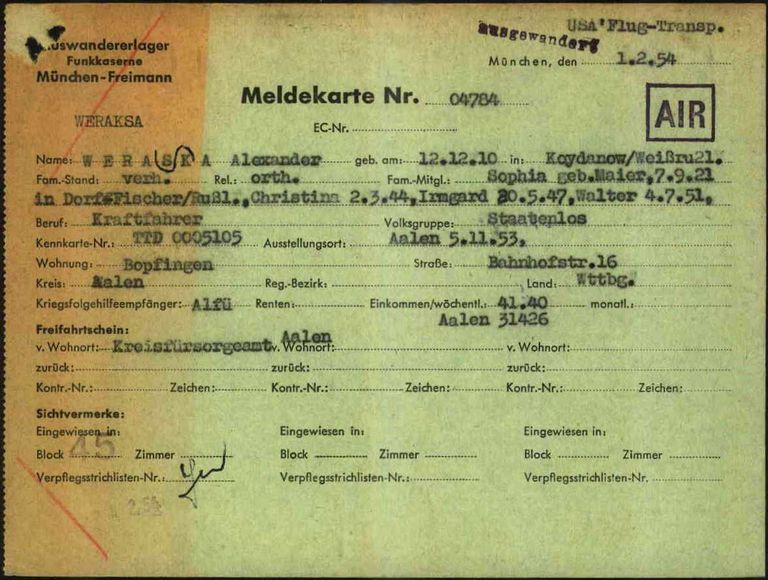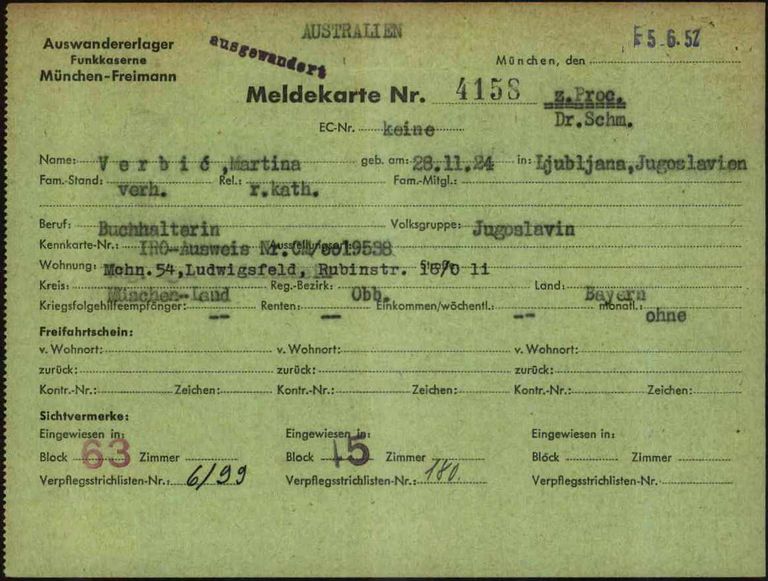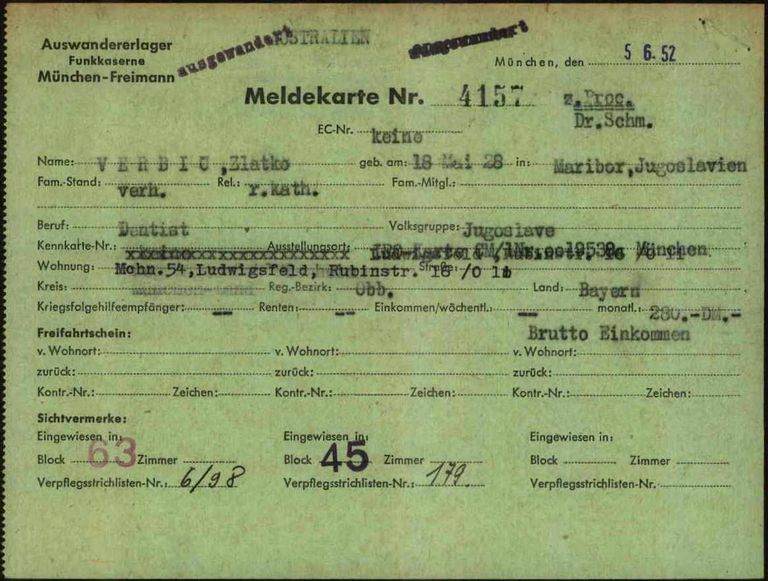Page of
Page/
- Reference
- Intro


In 1946, the Allies established a transit and resettlement center in the Funkkaserne, a former Wehrmacht barracks in the Munich district of Freimann. In this camp, Jewish and non-Jewish DPs prepared to return to their countries of origin or emigrate to a new home. From 1952, after the IRO ceased operating as an aid organization for DPs, many people who were not DPs also emigrated via the Funkkaserne resettlement center. The registration cards preserved in the Arolsen Archives come from this later period.
In 1946, the Allies established a transit and resettlement center in the Funkkaserne, a former Wehrmacht barracks in the Munich district of Freimann. In this camp, Jewish and non-Jewish DPs prepared to return to their countries of origin or emigrate to a new home. From 1952, after the IRO ceased operating as an aid organization for DPs, many people who were not DPs also emigrated via the Funkkaserne resettlement center. The registration cards preserved in the Arolsen Archives come from this later period.
Questions and answers
-
Where was the document used and who created it?
Representatives of UNRRA and the IRO set up special DP camps so that they could more easily arrange the DPs’ transit and emigration. In these transit or resettlement centers, as they were known, DPs completed the last emigration formalities before departing by ship or plane. There was a resettlement center for Jewish and non-Jewish DPs in a former radio barracks (Funkkaserne) in Munich-Freimann. This camp continued to be used after the IRO was disbanded. Camp administrative employees filled out registration cards and other documents for the emigrants. On these cards, they noted all of the main steps to be taken before the DPs’ departure. Unfortunately, not much is known about the further use of the Funkkaserne in the 1950s. However, there are indications that the Intergovernmental Committee for European Migration (ICEM) may have made emigration arrangements there from 1952 onward. It is also not possible to say exactly which department in the Funkkaserne used these registration cards. What is certain, however, is that there was a registration office and a card file office, either of which could have used the registration cards.
- When was the document used?
The registration cards come from the 1950s. They were created from 1952 onward after the DP camp closed and the IRO was disbanded. One of the latest departure dates noted on a card from the resettlement center is from 1959. This means the cards were still being used in Munich at least until this point.
- What was the document used for?
The departure of hundreds of thousands of DPs and other emigrants was a huge logistical task. The trains, planes and ships, in particular, could not sit idle for very long, and when they set off they were supposed to be completely filled. To ensure that this process went smoothly, there were various resettlement centers, also known as embarkation or transit camps. This is where the emigrants took care of all the steps necessary before departing: they received passports and valid papers, if necessary, they were assigned to transports and their luggage was inspected and checked in. The emigrants were also examined by doctors, and one final review was conducted to make sure there was no reason they could not leave. The emigrants could then board the ships at the embarkation point without much time being wasted. The cover sheet for a transport list that has been preserved in the Arolsen Archives reveals just how quickly the process could take place at a port: People who had left the Funkkaserne resettlement center by train on September 17, 1955, were already able to board their ship on September 21.
To prepare for their departure, the DPs and other emigrants from various camps and towns in southern Germany assembled at the resettlement center in Munich-Freimann. The registration cards that were created for them clearly show what happened in this center: they were registered, housed in a room and recorded on a rations check list. Once their destination countries had approved their emigration, camp employees assigned the emigrants to a transport. They then left Germany by ship or plane.
There were registration cards in many DP camps and resettlement centers. The camp employees used them to maintain an overview of who was living in the camp where at what time, as well as where people were emigrating to and when they were leaving. Registration cards and other documents from the Funkkaserne resettlement center have been preserved in the Arolsen Archives. For example, the postwar card file holds green registration certificates that were used as camp identity cards in the Funkkaserne, as well as yellow registration certificates for checking in and out of the individual departments in the resettlement center. There was also a yellow registration card with fields for family members and information about medical exams. More research is required to determine how these documents relate to the green registration card, meaning whether or not they were used in different departments for different purposes. One theory is that the DPs carried the green registration certificate with them as their camp identity card, while the registration cards were left with the camp administrative employees.
- How common is the document?
Unfortunately, it is not possible to say how many registration cards from the Funkkaserne can be found among the 3.5 million documents in the postwar card file (Nachkriegszeitkartei, Collection 3.1.1.1). ITS employees organized the cards following an alphabetical-phonetic system and placed them with other documents in the postwar card file. This made it easier to search for references to people, but it also means that it is no longer possible to determine how common the cards from the Funkkaserne are. However, spot checks have shown that the Arolsen Archives do not have cards for every single person who left the resettlement center in Munich according to the transport lists. But in the near future, modern computer technology will find a more accurate answer to the question of how many cards there are: clustering techniques will make it possible to virtually reassemble the card file from Munich – as well as other card files.
- What should be considered when working with the document?
ITS employees placed the cards in the postwar card file, which holds many different documents about Displaced Persons. It is important to note, however, that the registration cards from the Funkkaserne resettlement camp do not relate only to DPs. Cards have also been preserved from other emigrants who departed via Munich-Freimann but who were not DPs in the strictest sense.
If a registration card for an individual has been preserved in the Arolsen Archives, it is always worth checking the corresponding passenger lists that have also been archived. Since people were sometimes crossed off these lists shortly before they were supposed to depart – because they had fallen ill, for example – the lists can be used to verify whether the information on the registration cards is correct and the person actually left. The lists can be viewed in the online archive.
If you have any additional information about these cards, we would appreciate it very much if you could send your feedback to eguide@arolsen-archives.org. New findings can always be incorporated into the e-Guide and shared with everyone.
Help for documents
About the scan of this document <br> Markings on scan <br> Questions and answers about the document <br> More sample cards <br> Variants of the document


